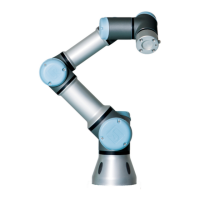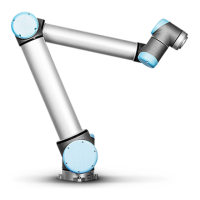1.7 Risk Assessment
Identifying the correct safety configuration settings is a particularly important part of developing
collaborative robot applications. See chapter 2 and part II for detailed information.
Some safety-related features are purposely designed for collaborative robot applications. These
features are configurable through the safety configuration settings and are particularly relevant
when addressing specific risks in the risk assessment conducted by the integrator:
• Force and power limiting: Used to reduce clamping forces and pressures exerted by the robot
in the direction of movement in case of collisions between the robot and the operator.
• Momentum limiting: Used to reduce high transient energy and impact forces in case of colli-
sions between robot and operator by reducing the speed of the robot.
• TCP and tool/end effector position limiting: Particularly used to reduce risks associated with
certain body parts. E.g. to avoid movement towards head and neck.
• TCP and tool/end effector orientation limiting: Particularly used to reduce risks associated
with certain areas and features of the tool/end effector and work-piece. E.g. to avoid sharp
edges to be pointed towards the operator.
• Speed limitation: Particularly used to ensure a low speed of the robot arm.
The integrator must prevent unauthorized access to the safety configuration by using password
protection.
A collaborative robot application risk assessment for contacts that are intentional and/or due to
reasonably foreseeable misuse is required and must address:
• Severity of individual potential collisions
• Likeliness of occurrence of individual potential collisions
• Possibility to avoid individual potential collisions
If the robot is installed in a non-collaborative robot application where hazards cannot be reasonably
eliminated or risks cannot be sufficiently reduced by use of the built-in safety-related functions (e.g.
when using a hazardous tool/end effector), then the risk assessment conducted by the integrator
must conclude the need for additional protective measures (e.g. an enabling device to protect the
operator during set-up and programming).
Universal Robots identifies the potential significant hazards listed below as hazards that must be
considered by the integrator.
Note: Other significant hazards can be present in a specific robot installation.
1. Entrapment of fingers between robot arm cable connector and base (Joint 0).
2. Entrapment of fingers between robot foot and base (Joint 0).
3. Entrapment of fingers between robot wrist 1 and robot wrist 2 (Joint 3 and Joint 4).
4. Penetration of skin by sharp edges and sharp points on tool/end effector or tool/end effector
connector.
5. Penetration of skin by sharp edges and sharp points on obstacles near the robot track.
6. Bruising due to contact with the robot.
Version 3.10
Copyright © 2009–2019 by Universal Robots A/S. All rights reserved.
I-9 UR3/CB3

